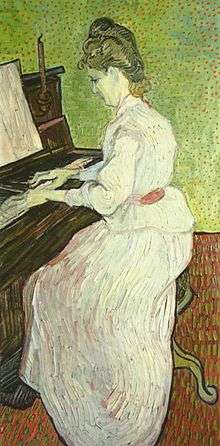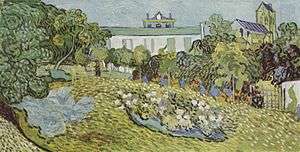Double-square painting
Double-square paintings have uncommonly large canvases. Vincent van Gogh, for example, used them almost exclusively during the final weeks of his life in Auvers, in June and July 1890.[1] To arrive at this size, Van Gogh simply had to combine the legs of two standard sizes: the 50 cm leg from a size 12 and the 100 cm leg of a size 40 stretcher. The result was a double-square of 50 x 100 cm, and from this size easily the square could be derived by using two 50 cm legs.
Other artists prior to Van Gogh such as Charles-François Daubigny and Puvis de Chavannes[2] had used canvases of similar proportions, and Van Gogh was aware of this. But his choice of this size points into another direction. His double-squares can easily be combined with size 30 canvases to more elaborated décorations, and his squares extend these possibilities.
One dimension of a double-square canvas is twice the size of the other. In other words, the canvas is the shape of two adjoining squares. The overall effect of this is stability, and the compositional challenge is to avoid monotony.
Van Gogh's Double-square canvases

.jpg)
 Wheat Fields near Auvers, June–July 1890, Österreichische Galerie Belvedere, Vienna
Wheat Fields near Auvers, June–July 1890, Österreichische Galerie Belvedere, Vienna Sheaves of Wheat, 1890, Dallas Museum of Art (F771)
Sheaves of Wheat, 1890, Dallas Museum of Art (F771) Field with Stacks of Grain, July 1890, Beyeler Foundation, Riehen, Switzerland (F809)
Field with Stacks of Grain, July 1890, Beyeler Foundation, Riehen, Switzerland (F809).jpg) Undergrowth with Two Figures, June 1890, Cincinnati Museum of Art
Undergrowth with Two Figures, June 1890, Cincinnati Museum of Art
_-_Wheat_Field_with_Crows_(1890).jpg)
 Wheatfieldd Under Thunderclouds, July 1890, Van Gogh Museum, Amsterdam
Wheatfieldd Under Thunderclouds, July 1890, Van Gogh Museum, Amsterdam Landscape with Castle Auvers at Sunset, June 1890, Van Gogh Museum, Amsterdam (F770)
Landscape with Castle Auvers at Sunset, June 1890, Van Gogh Museum, Amsterdam (F770) Landscape at Auvers in the Rain, July 1890, National Museum Cardiff, Wales
Landscape at Auvers in the Rain, July 1890, National Museum Cardiff, Wales Daubigny's Garden, July 1890, Auvers, Kunstmuseum Basel Basel. Barbizon painter Charles Daubigny moved to Auvers in 1861. Pictorially he put Auvers on the map, attracting artists Camille Corot and Honoré Daumier among others, and in 1890 Vincent van Gogh. Vincent made a second version of Daubigny's Garden in July 1890, and they are among his final works.[3]
Daubigny's Garden, July 1890, Auvers, Kunstmuseum Basel Basel. Barbizon painter Charles Daubigny moved to Auvers in 1861. Pictorially he put Auvers on the map, attracting artists Camille Corot and Honoré Daumier among others, and in 1890 Vincent van Gogh. Vincent made a second version of Daubigny's Garden in July 1890, and they are among his final works.[3]
Subsequent uses of the dimensions
Ivon Hitchens worked primarily in double-squares at certain periods in his career.
Footnotes
- ↑ These terms were coined by Ronald Pickvance, one of the leading experts in Van Gogh-research.
- ↑ Hammacher, A. M. The Ten Creative Years of Vincent van Gogh, Harry N. Abrams, New York, 1968. page 175
- ↑ Pickvance (1986), 272-273
References
- Pickvance, Ronald:
- Zemel, Carol: